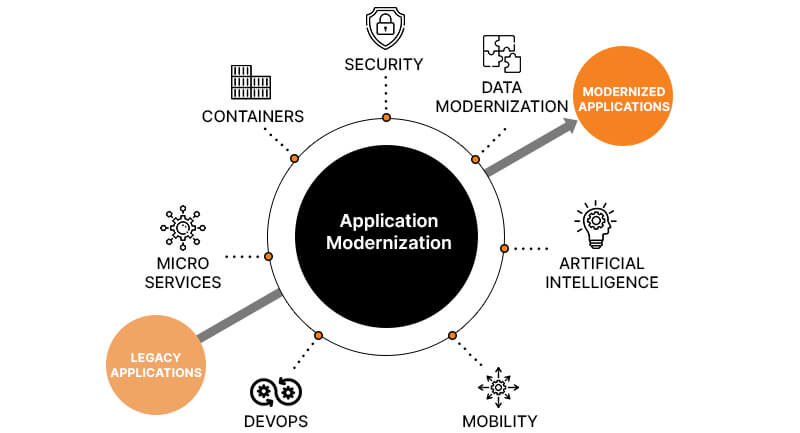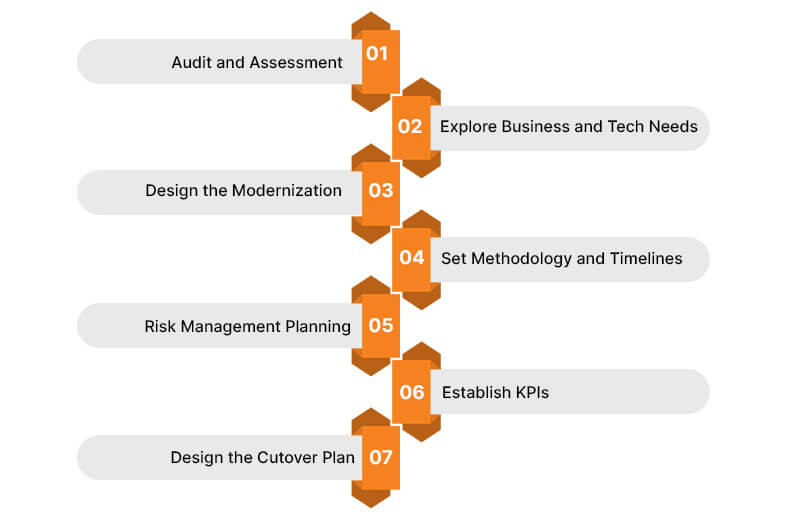In today’s digital age, keeping up with technological advancements is crucial for the success of any enterprise. One way to achieve this is through application modernization, which involves updating legacy applications with modern technology and architecture. However, this can be a complex and daunting process that requires careful planning and execution. Building an effective application modernization roadmap can help enterprises streamline the process and ensure a successful outcome.
So in this blog post, we will explore the essential steps in building a practical application modernization roadmap, from assessing the existing application landscape to selecting the right modernization approach. By following these steps, enterprises can modernize their applications, improve their overall IT infrastructure, and stay competitive in the ever-changing digital landscape.
So whether you’re just starting out or are well into the modernization process, read on to learn how to create a roadmap that will guide you toward success.
A Quick Understanding of the Application Modernization Roadmap

An application modernization roadmap is a strategic plan that outlines the steps needed to modernize an existing software application to improve its functionality, performance, and user experience. It involves a comprehensive analysis of the current application architecture, identifying its strengths, weaknesses, and potential areas for improvement.
The application modernization roadmap guides all stakeholders involved in the modernization effort, including developers, project managers, and business leaders. It helps ensure that everyone is aligned and working towards a common goal, reducing the chances of misunderstandings and delays. Additionally, it provides a framework for measuring progress and success, allowing the team to adjust course if necessary.
According to Statista, The global application modernization tools market was valued at 8.04 billion U.S. dollars in 2018. The market is expected to grow rapidly in the coming years and reach the size of 36.86 billion U.S. dollars by 2027. The need for digital transformation is driving the demand for application modernization tools.
Benefits of Having an Application Modernization Roadmap
Here are three benefits of having an application modernization roadmap:
1. Provides Clarity and Direction
One of the primary benefits of having a web application development roadmap is that it provides a clear direction for the modernization effort. It outlines the steps needed to achieve the desired outcome and ensures that everyone involved in the process is aligned with the overall goal. Without a roadmap, the modernization effort can quickly become overwhelming, with team members unsure of what they should be doing or what the end result should look like.
2. Reduces Risk
A well-defined roadmap considers potential risks and challenges that may arise during the modernization effort, allowing the team to prepare for and mitigate them. This can include technical risks, such as compatibility issues between different systems, or organizational risks, such as stakeholder resistance. By anticipating these risks and planning for them in advance, the team can reduce the overall risk associated with the modernization effort.
3. Promotes Collaboration and Communication
The roadmap is a common reference point for all stakeholders, promoting better team collaboration and communication. The roadmap can help break down silos and promote cross-functional collaboration by providing a clear overview of the modernization effort. Additionally, it ensures that everyone involved in the process is aware of what is happening and what their role is in achieving the desired outcome.
Learn also the Major Product Development Mistakes to Avoid for Startups in 2023.
7 Steps to Creating an Application Modernization Roadmap

1. Audit and Assessment
The first step in creating an application modernization roadmap is to audit and assess the existing application architecture. This involves analyzing the application’s strengths, weaknesses, and potential areas for improvement. This step helps establish a baseline for the modernization effort, identifying what needs to be changed and what can remain the same.
2. Explore Business and Tech Needs
The next step is to explore the application’s business and technical needs. This includes understanding how the application fits into the enterprise’s overall strategy and identifying any key business drivers for the modernization effort. Additionally, it involves analyzing the technical requirements for the modernized application, including any new technologies or systems that may need to be integrated.
3. Design the Modernization
To design an ideal modernization plan, you must review your requirements, determine the desired outcome, and decide how to apply your resources, given the budget and timeline you have in hand.
4. Set Methodology and Timelines
Once the modernization plan has been designed, the team needs to establish a methodology and timelines for executing the plan. This includes determining what steps must be taken, in what order, and by whom. Additionally, it involves setting realistic timelines for each step, considering any dependencies or constraints.
5. Risk Management Planning
As with any complex project, there are risks associated with application modernization. To mitigate these risks, the team needs to develop a risk management plan that identifies potential risks and outlines how they will be addressed. This includes defining risk thresholds, creating contingency plans, and establishing a process for monitoring and mitigating risks throughout the modernization effort.
6. Establish KPIs
To ensure that the modernization effort is successful, the team needs to establish key performance indicators (KPIs) that will be used to measure progress and success. This includes identifying specific metrics that will be tracked, such as application performance, user satisfaction, and business value delivered.
7. Design the Cutover Plan
Finally, the team needs to design a cutover plan that outlines how the modernized application will be transitioned from the existing architecture to the new one. This includes defining the testing and validation process, establishing the migration timeline, and identifying any potential issues that may arise during the cutover process.
Key Considerations Before Starting an Application Modernization
Here are three key considerations to keep in mind before starting an application modernization effort:
1. Business Objectives
It is essential to understand the enterprise’s overall business objectives and how the application modernization effort fits into them. This includes understanding how the modernization effort can help achieve specific business goals, such as increasing revenue, improving customer satisfaction, or reducing costs. By aligning the modernization effort with the enterprise’s business objectives, it’s more likely to deliver value and be seen as a success.
2. Resource Availability
Modernizing an application can be complex and resource-intensive, requiring specialized skills and knowledge. Therefore, assessing the enterprise’s resource availability is vital, including internal resources (IT staff and infrastructure) and external resources (technology partners and vendors). This includes understanding whether the enterprise has the necessary expertise and resources to execute the modernization effort successfully or if additional resources need to be brought in.
3. Technology Strategy
An application modernization effort is not a one-time event but a continuous process requiring ongoing maintenance and optimization. As such, it’s important to have a long-term technology strategy that supports the enterprise’s overall business objectives. This includes understanding the enterprise’s current technology landscape, identifying potential areas for improvement, and establishing a roadmap for future technology investments.
Final Words
Creating an application modernization roadmap is a complex process that requires careful planning, coordination, and execution. Enterprises can increase their chances of success by following the seven steps outlined above and considering key factors such as business objectives, resource availability, and technology strategy.
However, it’s also important to note that executing an application modernization effort requires skilled developers with the knowledge and expertise to implement modernization plans effectively. Skilled developers play a crucial role in identifying the right modernization strategies, designing and implementing new architectures, and ensuring that the new application is secure, scalable, and performs optimally.
Therefore, enterprises must hire software developers who can support the enterprise web application modernization efforts by training existing staff or hiring new talent. By doing so, they can ensure they have the technical expertise to successfully execute modernization plans and stay competitive in an increasingly digital world.
Jetpack over the skill gap and stand out from the competition.
Hire Our Dedicated Teams
Summary
Kickstart Your Project With Us!
Popular Posts
CONTACT US
Let's Build Your Agile Team.
Experience Netsmartz for 40 hours - No Cost, No Obligation.
Connect With Us Today!
Please fill out the form or send us an email to







